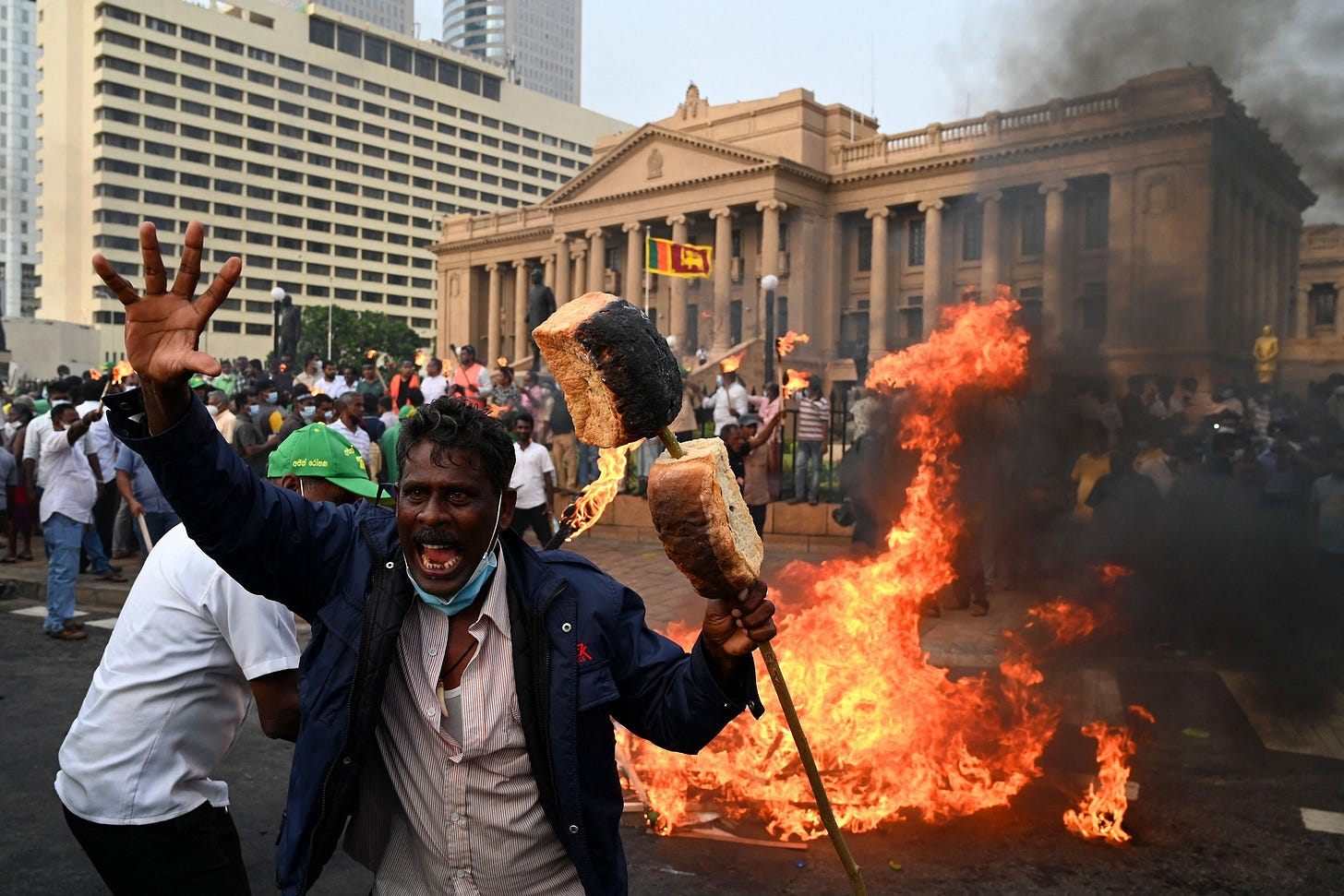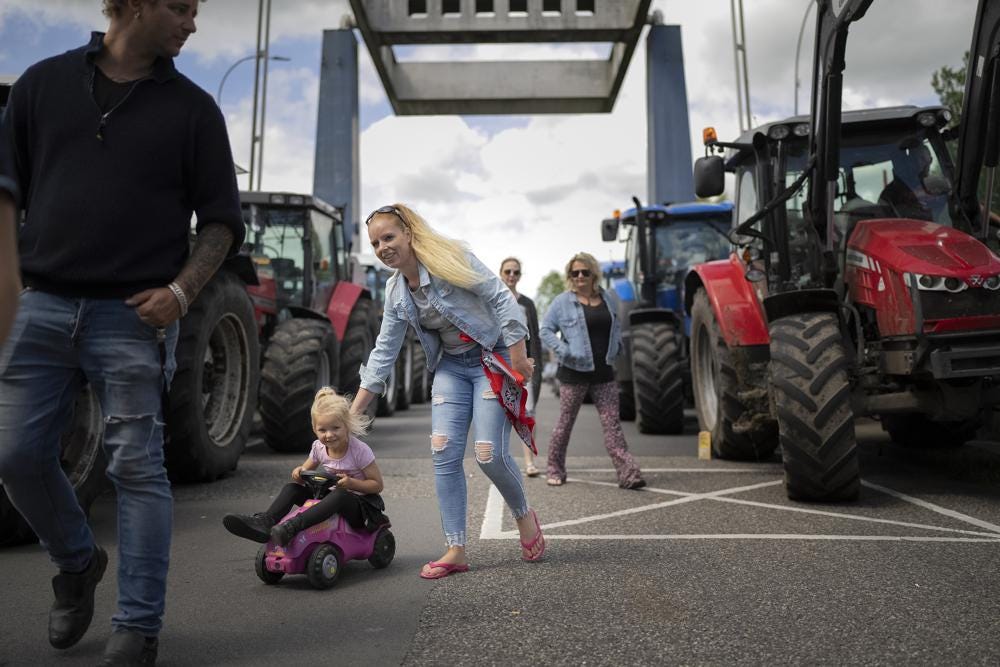Fertilizer Ban Led to Sri Lanka's Downfall, Police Shooting at Dutch Farmers, UN Blames Ukraine for Nursing Home Deaths, Starbucks Closing Stores Due to Employee Safety Issues (The Five for 07/13/22)
Hey, welcome to The Five.
Heavy day in the world today…check back on Friday for some Culture & Commentary that will feature some happier news.
But this outlet publishes on the news as it is happening…and this is what’s happening.
[one]
The downfall of a nation is never simple…but at this point it’s pretty clear that Sri Lanka fell into anarchy this week….over the rejection of modern farming practices that have resulted in failed crops, hunger and poverty.
A guest post on Bari Weiss’ Substack by Michael Shellenberger (the full post is for paid subscribers only):
The underlying reason for the fall of Sri Lanka is that its leaders—starting with former President Maithripala Sirisena and continuing with his successor, the recently deposed Gotabaya Rajapaksa—fell under the spell of Western green elites peddling organic agriculture and “ESG,” which refers to investments made following supposedly higher Environmental, Social, and Governance criteria. Sri Lanka has a near-perfect ESG score of 98—higher than Sweden (96) and the United States (51).
But the biggest problem was Sri Lanka’s chemical fertilizer ban, which passed last year and was central to the country’s effort to comply with ESG.
The numbers are shocking.
One-third of Sri Lanka’s farm lands were dormant in 2021 due to the fertilizer ban. Over 90 percent of Sri Lanka’s farmers had used chemical fertilizers before they were banned. After they were banned, an astonishing 85 percent experienced crop losses. Rice production fell 20 percent and prices skyrocketed 50 percent in just six months. Sri Lanka had to import $450 million worth of rice despite having been self-sufficient just months earlier. The price of carrots and tomatoes rose fivefold. All this had a dramatic impact on the more than 15 million people of the country’s 22 million people who are directly or indirectly dependent on farming.
Things were worse for smaller farmers. In the Rajanganaya region, where the majority of farmers operate two-and-a-half-acre lots, families reported 50 percent to 60 percent reductions in their harvest. “Before the ban, this was one of the biggest markets in the country, with tons and tons of rice and vegetables,” one farmer said earlier this year. “But after the ban, it became almost zero. If you talk to the rice mills, they don’t have any stock because people’s harvest dropped so much. The income of this whole community has dropped to an extremely low level.”
But the damage to tea was the key to Sri Lanka’s ruin. Before 2021, tea production generated $1.3 billion in exports annually. Tea exports paid for 71 percent of the nation’s food imports before 2021.
[two]
A similar, but less dramatic, situation is unfolding in The Netherlands, where Nitrogen fertilizer is also being banned…resulting in the police shooting at unarmed farmers:
Bales of hay lie burning along Dutch highways. Supermarket shelves stand empty because distribution centers are blocked by farmers. Then, at dusk, a police officer pulls his pistol and shoots at a tractor.
Dutch farmers are embroiled in a summer of discontent that shows no sign of abating. Their target? Government plans to rein in emissions of nitrogen oxide and ammonia that they say threatens to wreck their agricultural way of life and put them out of business.
The reduction targets could radically alter the Netherlands’ lucrative agriculture sector, which is known for its intensive farming, and may also foreshadow similar reforms — and protests — in other European nations whose farmers also pump out pollutants.
[three]
On July 1, the Indianapolis Star, also known as the IndyStar, published an article, written by the newspaper’s medical writer, about how women seeking abortions had begun traveling from Ohio to Indiana, where less restrictive abortion laws were still in place. “Patients head to Indiana for abortion services as other states restrict care,” the article was headlined.
That was a benign headline. But it was the anecdotal beginning that caught the attention of other news organizations. The article said that three days after the June 24 court ruling, an Indianapolis obstetrician-gynecologist, Caitlan Bernard, who performs abortions, received a call from “a child abuse doctor” in Ohio who had a 10-year-old patient who was six weeks and three days pregnant. Unable to obtain an abortion in Ohio, “the girl soon was on her way to Indiana to Bernard’s care,” the Star reported.
The only source cited for the anecdote was Bernard. She’s on the record, but there is no indication that the newspaper made other attempts to confirm her account. The story’s lead reporter, Shari Rudavsky, did not respond to a query asking whether additional sourcing was obtained. A Gannett spokeswoman provided a comment from Bro Krift, the newspaper’s executive editor: “The facts and sourcing about people crossing state lines into Indiana, including the 10-year-old girl, for abortions are clear. We have no additional comment at this time.”
The story is difficult, and heartbreaking…and also not confirmed.
Under Ohio law, a physician, as a mandated reporter under Ohio Revised Code 2151.421, would be required to report any case of known or suspected physical, sexual or emotional abuse or neglect of a child to their local child welfare or law enforcement agency. So Bernard’s colleague would have had to make such a report to law enforcement at the same time he or she contacted Bernard. Presumably then a criminal case would have been opened.
Then, the story was updated again, when an arrest was reported.
Update, July 13: The Columbus Dispatch reported that a 27-year-old Columbus man had been charged with impregnating a 10-year-old Ohio girl who had traveled to Indianapolis for an abortion on June 30. Gershon Fuentes was arrested July 13 “after police say he confessed to raping the child on at least two occasions,” the newspaper reported “He’s since been charged with rape, a felony of the first degree in Ohio.”
A police detective testified that “Columbus police were made aware of the girl’s pregnancy through a referral by Franklin County Children Services that was made by her mother on June 22,” the Dispatch said. While reporting this story, the Fact Checker had contacted the Franklin County agency to ask if such a referral had been made. Unlike similar Ohio county agencies we contacted, Franklin County officials did not offer a response.
This still doesn’t give us a full picture of what happened, or how much of the original story is true, as the Ohio doctor never reported anything…and the Indianapolis Star ran a single source as a story without fact-checking.
At least one of these parties is lying:
A.) Dr. Caitlan Bernard
B.) The Ohio Doctor
C.) The Indiapolis Star reporter
D.) The Ohio and/or Indianapolis police.
The Five is an outlet that’s consistently critical of the mainstream media…but that criticism is always with the nuance that on-the-ground reporting is often very difficult, and always under tight deadlines.
This story will likely be updated in future issues of The Five.
[four]
In a developing story…both Russia and Ukraine are being blamed for an attack by Kremlin-backed rebels carrying out an attack on a nursing home that killed dozens of elderly Ukranians.
PBS reports:
In a war awash in atrocities, the attack on the nursing home near the village of Stara Krasnyanka stood out for its cruelty. And Ukrainian authorities placed the fault squarely on Moscow, accusing Russia of killing more than 50 vulnerable civilians in a brutal and unprovoked attack.
But a new United Nations report has found that Ukraine’s armed forces bear a large, and perhaps equal, share of the blame for what happened at the care home in Stara Krasnyanka, which is about 360 miles southeast of Kyiv. A few days before the March 11 attack, Ukrainian soldiers took up positions inside the nursing home, effectively making the building a target.
At least 22 of the nursing home’s 71 patients survived the assault, according to the U.N., “but the exact number of persons killed remains unknown.”
[five]
Finally, Starbucks is closing stores in locations that threaten the safety of their baristas.
Starbucks is planning to close 16 locations across various cities, citing safety concerns.
"After careful consideration, we are closing some stores in locations that have experienced a high volume of challenging incidents that make it unsafe to continue to operate," a spokesperson told CNN Business in an email.
The stores are in Seattle; Los Angeles; Philadelphia; Washington, DC, and Portland, Oregon. They will be closed by the end of July.
The decision comes as Starbucks works to change the company culture under interim CEO Howard Schultz — and as employees across the country vote to unionize.
In a Monday letter to employees, Debbie Stroud and Denise Nelson, both senior vice presidents of US operations, discussed safety in Starbucks stores.
Until the next one,
-sth






